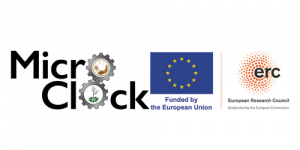About the MicroClock Project
Circadian clocks are biological timekeepers. They structure processes—from molecular pathways to behavioural attributes—over the 24h day. They are pervasive in eukaryotes yet remain almost completely unknown in non-photosynthetic bacteria, despite these being the most ancient lifeforms on Earth that evolved for 4 billion years under environmental cycles caused by the Earth’s rotation. We are addressing this major knowledge gap by capitalising on our recent discovery of a circadian clock in Bacillus subtilis. Furthermore, we propose that the mutualistic interactions between microbes and organisms in their environment utilise circadian clocks (“temporal mutualism”).
In MicroClock, we have several focal points. The first is to identify and understand the molecular structure and function of the Bacillus subtilis circadian clock. This part of the project is augmented by input from a DFG grant to the Merrow lab and a BBSRC grant to the Dodd lab. This will provide the first detailed characterisation of a circadian clock in a non-photosynthetic bacterium.
Armed with tools from this aspect of the project, we will delve into the interactions that occur between Bacillus subtilis and plant circadian clocks to define the new concept of temporal mutualism. We also find that co-culture of Bacillus subtilis with other microorganisms produces a stable system with a robust circadian clock. We will use this to reveal regulatory nodes that are common to plant/bacterium and fungus/bacterium temporal mutualism.
We will probe the additional novel hypothesis that Bacillus subtilis biofilm enables intra-species temporal mutualism via differentiated cell populations within the matrix-bound structure. We use circadian formalisms (behaviour), molecular systems analysis and state-of-the-art technological approaches (e.g., microfluidics, microscopy, reporter gene technology and optogenetics), which is only possible through our interdisciplinary collaboration.
We are excited to open a completely new field through our collaboration, bridging chronobiology with microbiology and ecology. We anticipate that the impacts of this work will be far-reaching, with insights being relevant to health, biotechnology, agriculture and ecology.
